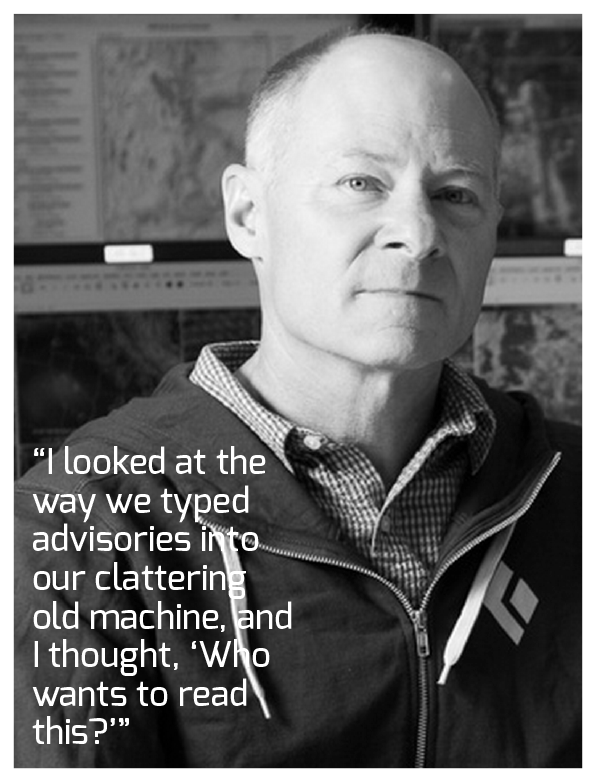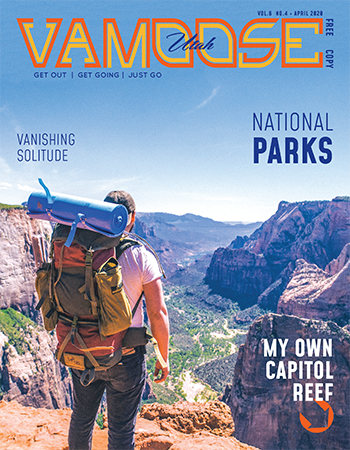When the longtime director of the
Utah Avalanche Center tells
snow stories, people listen
During the early ’80s, the Utah Avalanche Center’s daily advisories were keyed into a Teletype machine by bleary-eyed forecasters on pre-dawn mornings at the National Weather Service office. The rickety key-entry system inspired no literary flourishes: The forecasters’ tidings went live over the Weather Wire and on a single telephone answering machine. Just a small handful of backcountry users wandering the Wasatch on skinny telemark skis followed the forecasts.
Today, Utah Avalanche Center (UAC) forecasters come to the same office at the same ungodly hour, but that’s about where the similarities to those early days end. And much of that is thanks to Bruce Tremper, the man who’s served as director of the UAC for 29 years.
Regarding the accomplishments of UAC, Tremper doesn’t often say, “I.” It’s always, “We developed … ” or, “We instituted … ” Quite humble, the man was the force behind the most significant changes to shape avalanche forecasting and education. He’s widely regarded as a local hero and a leading national expert on snow safety. And he still spends as many days as possible touring the Wasatch, usually mentoring those following him up the skin-track.
When Tremper arrived at the UAC in the mid ’80s, he’d taken a lot of writing courses in grad school and learned the value of using storytelling to get people to listen. He was also fresh off a stint at the Alaska Avalanche Center, where his mentors were pioneering engaging and memorable ways to teach avalanche-safety courses.
“I looked at the way we typed advisories into our clattering old machine, and I thought, ‘Who wants to read this?’” Tremper says.
 And so, he shifted the UAC’s approach to follow his mentors’ lead and expand upon their insights. At his first annual meeting with local avalanche professionals, he cajoled, “There’s no sense in putting out forecasts and classes if no one will remember what you said. After all, we’re in the entertainment business!”
And so, he shifted the UAC’s approach to follow his mentors’ lead and expand upon their insights. At his first annual meeting with local avalanche professionals, he cajoled, “There’s no sense in putting out forecasts and classes if no one will remember what you said. After all, we’re in the entertainment business!”
His colleagues laughed, but Tremper was dead serious.
The forecasters started injecting jokes, personal stories, metaphors and analogies into their morning phone recordings, and soon had to add 10 phone lines to handle the increased call volume. Meanwhile, avalanche courses suddenly became entertaining multimedia presentations with photos, videos and hand-built model avalanches.
Tremper, a self-described nerd, also jumped on the Internet train early on, and taught local, suspicious avalanche directors to use the first-generation Internet browser.
“We knew that people are visual learners, and they could digest information best when it was illustrated.”
“During [the 2002] Olympic games, we pioneered online graphics to illustrate avalanche advisories, and people loved it. And thus, we entered the modern world, whether we liked it or not,” says Tremper with a laugh.
Indeed, Tremper’s progressive approach to sharing information with the masses has been adopted by most major avalanche centers around the world. Graphics forged in the UAC’s avalanche reports are now the norm in avalanche forecasts and education.
“We’ve always paid very close attention to the cutting edge—and tried to anticipate what’s coming next so we can stay a step ahead,” Tremper says.
As backcountry user demographics expand to include more snowmobilers and a generation of tele-adverse Alpine tour skiers, education and advisory methods have to keep pace.
“It’s a brave new world. What comes next?” muses Tremper.
Tremper officially retired from his post as director of the UAC in 2015, but don’t expect him to fade from the “avy” scene. He’ll continue part-time on the UAC’s nonprofit side, creating informative videos to help us powder gluttons stay safe. So say hello if you see him out on the skin track—and thank him while you’re at it. He’s likely had a lot to do with your snow-safety education.



